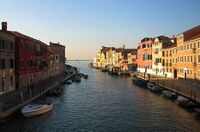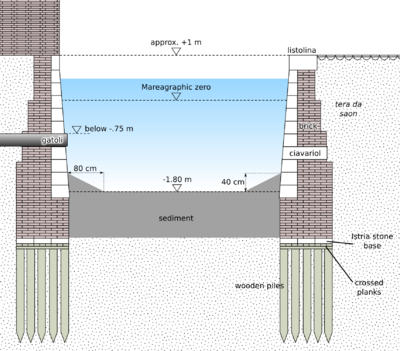Canal: Difference between revisions
No edit summary |
DBossalini (talk | contribs) |
||
| (One intermediate revision by one other user not shown) | |||
| Line 4: | Line 4: | ||
[[File:Cannaregio canal.jpg|right|thumb|200px| A canal segment of rii de Cannaregio.]] | [[File:Cannaregio canal.jpg|right|thumb|200px| A canal segment of rii de Cannaregio.]] | ||
Every [[canal]] is broken up into [[Canal Segments]] by intersections. For research and organizational purposes [[Canal Segments]] are given sub names originated from the [[canal]] name. | Every [[canal]] is broken up into [[Canal Segments]] by intersections. For research and organizational purposes [[Canal Segments]] are given sub names originated from the [[canal]] name. | ||
| Line 43: | Line 42: | ||
*[[Canal Wall Damage]] | *[[Canal Wall Damage]] | ||
*[[Canal Maintenance]] | *[[Canal Maintenance]] | ||
*[[List of Canals]] | |||
*[[List of Canal Segments]] | |||
==References== | ==References== | ||
Latest revision as of 16:57, 19 December 2013
This article contains information about a generic Venetian canal.
A Venetian canal, know to Venetians as a rio, is a remnant of an ancient natural waterway. The canals today resemble their original appearance but have transformed slightly due to human intervention. A canal can be classified as an inner canal or and outer canal. An inner canal separates two islands in the historic center of Venice, while an outer canal runs along the exterior of Islands in the lagoon. A canal may vary in size, shape, and number of intersections however its anatomy is typically consistent, as explained below. [1]

Every canal is broken up into Canal Segments by intersections. For research and organizational purposes Canal Segments are given sub names originated from the canal name.
Coding
For information systems every canal is given a code name to make identification easier. To identify individual segments the code name is given a number.
Example: Rio de la Panada is coded as PANA ; each of its 3 segments are coded as PANA1, PANA2, PANA3 [2]
Anatomy

The bed of a typical canal is composed of gravel, sand, silt, clay. A canal is bounded by two walls, a defined earth bottom, and any other bodies of water with which it may intersect. A Canal Wall is typically brick lined with clay or Istria stone which protects the foundation of buildings from becoming saturated with water. The bottom of the canal is defined by a layer of sediment. This sediment is composed of natural solids brought in from the ocean, as well as from sewage remnants and degradation from the bounding Canal Wall. When a canal is Dredged, the set depth of a canal is defined by how much distance there is from the Zero Reference Point to the layer of remaining sediment (See Digging Restrictions).[3]
Canal Segmentation
Over the centuries, all the canals of Venice acquired one or more names. Several canals have multiple names in common Venetian parlance, giving rise to confusion. Official names were never codified until the 1990's. For research and organizational purposes, every canal is broken into Canal Segments. A Canal Segment is created when a canal is intersected by another canal or by a Rio Tera. The canal will retain its name across intersections but each Segment is assigned a specific segment code, based on the canal code, followed by a numeral, from north to south. For example Rio de la Panada, which has code PANA, is broken into three segments, from north to south: PANA 1, PANA 2, and PANA 3.[4]
Canal Hydrodynamics
The natural tides responsible for flushing out the Canals move sediment throughout the water ways. Sediment build up occurs naturally as a result of this process.
Canal Sedimentation
Over time, sedimentation begins to build up in the bottom of canals and needs to be removed by Canal Maintenance
Boat Traffic
Boats traveling along a canal create wakes known as Moto Ondoso. The constant boat traffic causes large wakes to hit the canal walls with great velocity. This can easily break off loose sediments of the walls and eat away at the stone as well as mortar. The deteriorating walls attribute to Sediment build up in the Canals.
Sewage
Industrial and household waste water are discharged into the canals and have minimal contributions to sediment build up.
See also
References
- ↑ "Venice and Its Lagoon". UNESCO. http://whc.unesco.org/en/list/394. Retrieved 2010.
- ↑ GIS Cloud. [1]
- ↑ Ing. Lorrenzo Bottazo, November 2011
- ↑ "Venice and Its Lagoon". UNESCO. http://whc.unesco.org/en/list/394. Retrieved 2010.